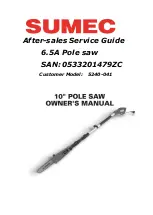
12
•
Under cut the branch 1/3 through for your first cut. Your second cut should
over cut to drop the branch off (Fig. 15). Be prepared to balance the weight of
the 10" pole saw when the limb falls.
•
Now make your finishing cut from the topside of the branch smoothly and
neatly against the main member so the bark will grow back to seal the wound .
•
Release the trigger ON/OFF switch as soon as the cut is completed.
Failure to follow proper cutting procedures will result in the bar and chain
binding and becoming pinched or trapped in the limb.
LIMBING
Limbing is the process of removing branches from a fallen tree.
•
You should cut limbs one at a time. Remove the cut limbs from the work area
often to help keep the work area clean and safe.
•
Cut branches under tension from the bottom up to avoid binding the 10" pole
saw.
•
Keep the tree between you and the 10" pole saw while limbing. Cut from the
side of the tree opposite the branch you are cutting.
IF THE SAW BECOMES PINCHED OR TRAPPED
1. Wait for the blade to stop, wait five minutes for the saw to cool, unplug the
power cord, and wear gloves to protect your hands f
「
om the chain teeth.
2. If you can reach the limb from the ground, lift the limb while holding the saw.
This should release the "pinch" and free the saw.
3. If the saw is still trapped, call a professional for assistance.
MINIMIZE KICKBACK
Kickback may occur when the moving chain contacts an object at the upper
portion of the tip of the guide bar or when the wood closes in and pinches the
10" pole saw in the cut. Contact at the upper portion of the tip of the guide bar
can cause the
chain to dig into the object and stop the chain for an instant. The


















